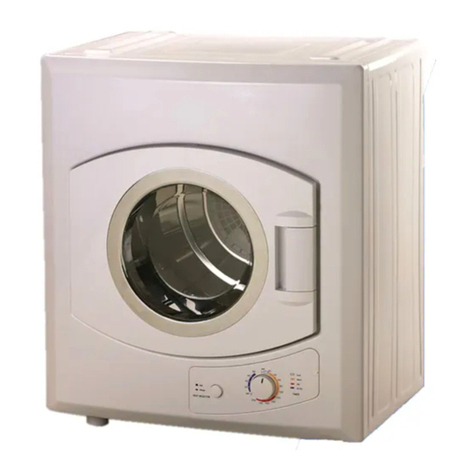2
- If the supply cord is damaged, it must be replaced by service agent or similarly qualied
persons in order to avoid a hazard.
- Avoid fabrics that contain vegetable or cooking oil or have been contaminated by hair
care products be placed in a tumble dryer they should be washed in hot water with extra
detergent, this will reduce, but not eliminate the hazard.
- Do not dry unwashed items in the tumble dryer.
- Items that have been soiled with substances such as cooking oil, acetone, alcohol, petrol,
kerosene, spot removers, turpentine, waxes and wax removers should be washed in hot
water with an extra amount of detergent before being dried in the tumble dryer.
- Fabric softeners, or similar products, should be used as specied by the fabric
softener instructions.
- The nal part of a tumble dryer cycle occurs without heat (cool down cycle) to ensure that
the items are left at a temperature that ensures that the items will not be damaged.
- Remove all objects from pockets such as lighters and matches.
To minimize the risk of re in a tumble dryer, the following should be observed:
- Items that have been spotted or soaked with vegetable or cooking oil constitute a re
hazard and should not be placed in a tumble dryer.
- If it is unavoidable that fabrics that contain vegetable or cooking oil or have been
contaminated by hair care products be placed in a tumble dryer they should rst be washed
in hot water with extra detergent - this will reduce, but not eliminate, the hazard. The‘cool
down’ cycle of tumble dryers should be used to reduce the temperature of the items. They
should not be removed from the tumble dryer or piled or stacked while hot.
- Items that have been previously cleaned in, washed in, soaked in or spotted with petrol/
gasoline, dry-cleaning solvents or other ammable or explosive substances should not be
placed in a tumble dryer.
- Highly ammable substances commonly used in domestic environments include acetone,
denatured alcohol, petrol/gasoline, kerosene, spot removers (some brands), turpentine,
waxes and wax removers.
- Items containing foam rubber (also known as latex foam) or similarly textured rubber. like
materials should not be dried in a tumble dryer on a heat setting.
Foam rubber materials can, when heated, produce re by spontaneous combustion.
-Fabric softeners or similar products should not be used in a tumble dryer to eliminate
the eects of static electricity unless this practice is specically recommended by the
manufacturer of the fabric softener or product.
- Undergarments that contain metal reinforcements should not be placed in a
tumble dryer.
-Damage to the tumble dryer can result if metal reinforcements come loose
during drying. When available a drying rack could be used for such items.
- Plastic articles such as shower caps or babies’waterproof napkin covers should not be
placed in a tumble dryer.
- Rubber-backed articles, clothes tted with foam rubber pads, pillows, galoshes and rubber
coated tennis shoes should not be placed in a tumble dryer.
Important Safety Instructions




























